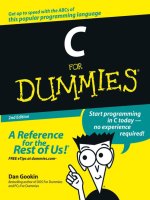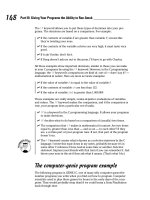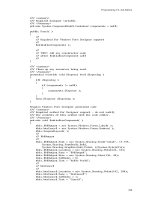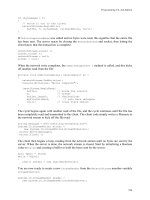Programming C# 2nd Edition phần 1 pptx
Bạn đang xem bản rút gọn của tài liệu. Xem và tải ngay bản đầy đủ của tài liệu tại đây (1.03 MB, 59 trang )
Programming C#, 2
nd
Edition
Jesse Liberty
Publisher: O'Reilly
Second Edition February 2002
ISBN: 0-596-00309-9, 648 pages
The first part of Programming C#, 2nd Edition introduces C# fundamentals, then goes on to
explain the development of desktop and Internet applications, including Windows Forms,
ADO.NET, ASP.NET (including Web Forms), and Web Services. Next, this book gets to the
heart of the .NET Framework, focusing on attributes and reflection, remoting, threads and
synchronization, streams, and finally, it illustrates how to interoperate with COM objects.
Table of Contents
Preface
About This Book
How the Book Is Organized
Who This Book Is For
C# Versus Visual Basic .NET
C# Versus Java
C# Versus C++
Conventions Used in This Book
Support
We'd Like to Hear from You
Acknowledgments
1
1
1
4
4
4
5
5
5
6
7
I: The C# Language
8
1. C# and the .NET Framework
1.1 The .NET Platform
1.2 The .NET Framework
1.3 Compilation and the MSIL
1.4 The C# Language
9
9
10
11
12
2. Getting Started: "Hello World"
2.1 Classes, Objects, and Types
2.2 Developing "Hello World"
2.3 Using the Visual Studio .NET Debugger
14
14
20
23
3. C# Language Fundamentals
3.1 Types
3.2 Variables and Constants
3.3 Expressions
3.4 Whitespace
3.5 Statements
3.6 Operators
3.7 Namespaces
3.8 Preprocessor Directives
26
26
30
36
36
37
51
59
60
4. Classes and Objects
4.1 Defining Classes
4.2 Creating Objects
4.3 Using Static Members
4.4 Destroying Objects
4.5 Passing Parameters
4.6 Overloading Methods and Constructors
4.7 Encapsulating Data with Properties
4.8 Readonly Fields
64
64
69
74
78
81
86
88
91
5. Inheritance and Polymorphism
5.1 Specialization and Generalization
5.2 Inheritance
5.3 Polymorphism
5.4 Abstract Classes
5.5 The Root of all Classes: Object
5.6 Boxing and Unboxing Types
5.7 Nesting Classes
93
93
95
99
104
108
109
111
6. Operator Overloading
6.1 Using the operator Keyword
6.2 Supporting Other .NET Languages
6.3 Creating Useful Operators
6.4 Logical Pairs
6.5 The Equals Operator
6.6 Conversion Operators
114
114
115
115
115
115
116
7. Structs
7.1 Defining Structs
7.2 Creating Structs
123
123
125
8. Interfaces
8.1 Implementing an Interface
8.2 Accessing Interface Methods
8.3 Overriding Interface Implementations
8.4 Explicit Interface Implementation
130
130
138
143
147
9. Arrays, Indexers, and Collections
9.1 Arrays
9.2 The foreach Statement
9.3 Indexers
9.4 Collection Interfaces
9.5 Array Lists
9.6 Queues
9.7 Stacks
9.8 Dictionaries
156
156
160
173
181
186
196
198
201
10. Strings and Regular Expressions
10.1 Strings
10.2 Regular Expressions
208
208
222
11. Handling Exceptions
11.1 Throwing and Catching Exceptions
11.2 Exception Objects
11.3 Custom Exceptions
11.4 Rethrowing Exceptions
233
233
242
245
247
12. Delegates and Events
12.1 Delegates
12.2 Events
251
251
270
II: Programming with C#
279
13. Building Windows Applications
13.1 Creating a Simple Windows Form
13.2 Creating a Windows Form Application
13.3 XML Documentation Comments
13.4 Deploying an Application
280
281
292
314
316
14. Accessing Data with ADO.NET
14.1 Relational Databases and SQL
14.2 The ADO.NET Object Model
14.3 Getting Started with ADO.NET
14.4 Using OLE DB Managed Providers
14.5 Working with Data-Bound Controls
14.6 Changing Database Records
14.7 ADO.NET and XML
326
326
329
331
335
337
348
363
15. Programming Web Applicationswith Web Forms
15.1 Understanding Web Forms
15.2 Creating a Web Form
15.3 Adding Controls
15.4 Data Binding
15.5 Responding to Postback Events
15.6 ASP.NET and C#
364
364
367
370
372
380
381
16. Programming Web Services
16.1 SOAP, WSDL, and Discovery
16.2 Building a Web Service
16.3 Creating the Proxy
382
382
383
389
III: Introduction to Web Services
394
17. Assemblies and Versioning
17.1 PE Files
17.2 Metadata
17.3 Security Boundary
17.4 Versioning
17.5 Manifests
17.6 Multi-Module Assemblies
17.7 Private Assemblies
17.8 Shared Assemblies
395
395
395
395
396
396
398
406
406
18. Attributes and Reflection
18.1 Attributes
18.2 Intrinsic Attributes
18.3 Custom Attributes
18.4 Reflection
18.5 Reflection Emit
412
412
412
414
418
428
19. Marshaling and Remoting
19.1 Application Domains
19.2 Context
19.3 Remoting
451
452
461
463
20. Threads and Synchronization
20.1 Threads
20.2 Synchronization
20.3 Race Conditions and Deadlocks
473
473
481
491
21. Streams
21.1 Files and Directories
21.2 Reading and Writing Data
21.3 Asynchronous I/O
21.4 Network I/O
21.5 Web Streams
21.6 Serialization
21.7 Isolated Storage
493
493
503
509
514
531
534
542
22. Programming .NET and COM
22.1 Importing ActiveX Controls
22.2 Importing COM Components
22.3 Exporting .NET Components
22.4 P/Invoke
22.5 Pointers
545
545
552
560
562
565
Glossary
570
Colophon
580
Programming C#, 2nd Edition
1
Preface
Every 10 years or so a new approach to programming hits like a tsunami. In the early 1980s,
the new technologies were Unix, which could be run on a desktop, and a powerful new
language called C, developed by AT&T. The early 90s brought Windows and C++. Each of
these developments represented a sea change in the way you approached programming. Now,
.NET and C# are the next wave, and this book is intended to help you ride it.
Microsoft has 'bet the company' on .NET. When a company of their size and influence spends
billions of dollars and reorganizes its entire corporate structure to support a new platform, it is
reasonable for programmers to take notice. It turns out that .NET represents a major change in
the way you'll think about programming. It is, in short, a new development platform designed
to facilitate object-oriented Internet development. The programming language of choice for
this object-oriented Internet-centric platform is C#, which builds on the lessons learned from
C (high performance), C++ (object-oriented structure), Java (garbage collected, high
security), and Visual Basic (rapid development) to create a new language ideally suited for
developing component-based n-tier distributed web applications.
About This Book
This book is a tutorial, both on C# and on writing .NET applications with C#. If you are
already proficient in a programming language, you may be able to skim a number of the early
chapters, but be sure to read through Chapter 1, which provides an overview of the language
and the .NET platform. If you are new to programming, you'll want to read the book as the
King of Hearts instructed the White Rabbit: "Begin at the beginning, and go on till you come
to the end: then stop.
1
How the Book Is Organized
Part I focuses on the details of the language. Part II details how to write .NET programs, and
Part III describes how to use C# with the .NET Common Language Runtime library.
Part I, The C# Language
Chapter 1, introduces you to the C# language and the .NET platform.
Chapter 2 demonstrates a simple program to provide a context for what follows, and
introduces you to the Visual Studio IDE and a number of C# language concepts.
Chapter 3, presents the basics of the language, from built-in datatypes to keywords.
Classes define new types and allow the programmer to extend the language so that you can
better model the problem you're trying to solve. Chapter 4, explains the components that form
the heart and soul of C#.
Classes can be complex representations and abstractions of things in the real world.
Chapter 5, discusses how classes relate and interact.
1
Alice's Adventures in Wonderland by Lewis Carroll.
Programming C#, 2nd Edition
2
Chapter 6, teaches you how to add operators to your user-defined types.
Chapter 7 and Chapter 8 introduce Structs and Interfaces, respectively, both close cousins to
classes. Structs are lightweight objects that are more restricted than classes, and that make
fewer demands on the operating system and on memory. Interfaces are contracts; they
describe how a class will work so that other programmers can interact with your objects in
well-defined ways.
Object-oriented programs often create a great many objects. It is often convenient to group
these objects and manipulate them together, and C# provides extensive support for
collections. Chapter 9, explores the collection classes provided by the Framework Class
Library and how to create your own collection types as well.
Chapter 10 discusses how you can use C# to manipulate text Strings and Regular
Expressions. Most Windows and web programs interact with the user, and strings play a vital
role in the user interface.
Chapter 11, explains how to deal with exceptions, which provide an object-oriented
mechanism for handling life's little emergencies.
Both Windows and web applications are event-driven. In C#, events are first-class members
of the language. Chapter 12, focuses on how events are managed, and how delegates (object-
oriented type-safe callback mechanisms) are used to support event handling.
Part II, Programming with C#
This section and the next will be of interest to all readers, no matter how much experience you
may already have with other programming languages. These sections explore the details of
the .NET platform.
Part II details how to write .NET programs: both desktop applications with Windows Forms
and web applications with Web Forms. In addition, Part II describes database interactivity and
how to create web services.
On top of this infrastructure sits a high-level abstraction of the operating system, designed to
facilitate object-oriented software development. This top tier includes ASP.NET and
Windows Forms. ASP.NET includes both Web Forms, for rapid development of web
applications, and web services, for creating web objects with no user interface.
C# provides a Rapid Application Development (RAD) model similar to that previously
available only in Visual Basic. Chapter 13, describes how to use this RAD model to create
professional-quality Windows programs using the Windows Forms development
environment.
Whether intended for the Web or for the desktop, most applications depend on the
manipulation and management of large amounts of data. Chapter 14, explains the ADO.NET
layer of the .NET Framework and explains how to interact with Microsoft SQL Server and
other data providers.
Programming C#, 2nd Edition
3
Chapter 15 combines the RAD techniques demonstrated in Chapter 13 with the data
techniques from Chapter 14 to demonstrate Building Web Applications with Web Forms.
Not all applications have a user interface. Chapter 16 focuses on the second half of ASP.NET
technology: Web Services. A web service is a distributed application that provides
functionality via standard web protocols, most commonly XML and HTTP.
Part III, The CLR and the .NET Framework
A runtime is an environment in which programs are executed. The Common Language
Runtime (CLR) is the heart of .NET. It includes a data-typing system which is enforced
throughout the platform and which is common to all languages developed for .NET. The CLR
is responsible for processes such as memory management and reference counting of objects.
Another key feature of the .NET CLR is garbage collection. Unlike with traditional C/C++
programming, in C# the developer is not responsible for destroying objects. Endless hours
spent searching for memory leaks are a thing of the past; the CLR cleans up after you when
your objects are no longer in use. The CLR's garbage collector checks the heap for
unreferenced objects and frees the memory used by these objects.
The .NET platform and class library extends upward into the middle-level platform, where
you find an infrastructure of supporting classes, including types for interprocess
communication, XML, threading, I/O, security, diagnostics, and so on. The middle tier also
includes the data-access components collectively referred to as ADO.NET, which are
discussed in Chapter 14.
Part III of this book discusses the relationship of C# to the Common Language Runtime and
the Framework Class Library.
Chapter 17, distinguishes between private and public assemblies and describes how
assemblies are created and managed. In .NET, an assembly is a collection of files that appears
to the user to be a single DLL or executable. An assembly is the basic unit of reuse,
versioning, security, and deployment.
.NET assemblies include extensive metadata about classes, methods, properties, events, and
so forth. This metadata is compiled into the program and retrieved programmatically through
reflection. Chapter 18, explores how to add metadata to your code, how to create custom
attributes, and how to access this metadata through reflection. It goes on to discuss dynamic
invocation, in which methods are invoked with late (runtime) binding, and ends with a
demonstration of reflection emit, an advanced technique for building self-modifying code.
The .NET Framework was designed to support web-based and distributed applications.
Components created in C# may reside within other processes on the same machine or on other
machines across the network or across the Internet. Marshaling is the technique of interacting
with objects that aren't really there, while remoting comprises techniques for communicating
with such objects. Chapter 19, elaborates.
The Framework Class Library provides extensive support for asynchronous I/O and other
classes that make explicit manipulation of threads unnecessary. However, C# does provide
extensive support for Threads and Synchronization, discussed in Chapter 20.
Programming C#, 2nd Edition
4
Chapter 21 discusses Streams, a mechanism not only for interacting with the user but also for
retrieving data across the Internet. This chapter includes full coverage of C# support for
serialization: the ability to write an object graph to disk and read it back again.
Chapter 22, explores interoperability the ability to interact with COM components created
outside the managed environment of the .NET Framework. It is possible to call components
from C# applications into COM and to call components from COM into C#. Chapter 22
describes how this is done.
The book concludes with an appendix of Glossary.
Who This Book Is For
Programming C#, Second Edition was written for programmers who want to develop
applications for the .NET platform. No doubt, many of you already have experience in C++,
Java, or Visual Basic (VB). Other readers may have experience with other programming
languages, and some readers may have no specific programming experience but perhaps have
been working with HTML and other web technologies. This book is written for all of you,
though if you have no programming experience at all, you may find some of it tough going.
C# Versus Visual Basic .NET
The premise of the .NET Framework is that all languages are created equal. To paraphrase
George Orwell, however, some languages are more equal than others. C# is an excellent
language for .NET development. You will find it is an extremely versatile, robust and well-
designed language. It is also currently the language most often used in articles and tutorials
about .NET programming.
It is likely that many VB programmers will choose to learn C#, rather than upgrading their
skills to VB.NET. This would not be surprising because the transition from VB6 to VB.NET
is, arguably, nearly as difficult as from VB6 to C# and, whether it's fair or not, historically,
C-family programmers have had higher earning potential than VB programmers. As a
practical matter, VB programmers have never gotten the respect or compensation they
deserve, and C# offers a wonderful chance to make a potentially lucrative transition.
In any case, if you do have VB experience, welcome! This book was designed with you in
mind too, and I've tried to make the conversion easy.
C# Versus Java
Java Programmers may look at C# with a mixture of trepidation, glee, and resentment. It has
been suggested that C# is somehow a "rip-off" of Java. I won't comment on the religious war
between Microsoft and the "anyone but Microsoft" crowd except to acknowledge that C#
certainly learned a great deal from Java. But then Java learned a great deal from C++, which
owed its syntax to C, which in turn was built on lessons learned in other languages. We all
stand on the shoulders of giants.
C# offers an easy transition for Java programmers; the syntax is very similar and the
semantics are familiar and comfortable. Java programmers will probably want to focus on the
differences between Java and C# in order to use the C# language effectively. I've tried to
Programming C#, 2nd Edition
5
provide a series of markers along the way (see the notes to Java programmers within the
chapters).
C# Versus C++
While it is possible to program in .NET with C++, it isn't easy or natural. Frankly, having
worked for ten years as a C++ programmer and written a dozen books on the subject, I'd
rather have my teeth drilled than work with managed C++. Perhaps it is just that C# is so
much friendlier. In any case, once I saw C#, I never looked back.
Be careful, though; there are a number of small traps along the way, and I've been careful to
mark these with flashing lights and yellow cones. You'll find notes for C++ programmers
throughout the book.
Conventions Used in This Book
The following font conventions are used in this book:
Italic is used for:
• Pathnames, filenames, and program names.
• Internet addresses, such as domain names and URLs.
• New terms where they are defined.
Constant Width is used for:
• Command lines and options that should be typed verbatim.
• Names and keywords in program examples, including method names, variable names,
and class names.
Constant Width Italic is used for replaceable items, such as variables or optional
elements, within syntax lines or code.
Constant Width Bold is used for emphasis within program code.
Pay special attention to notes set apart from the text with the following icons:
This is a tip. It contains useful supplementary information about the
topic at hand.
This is a warning. It helps you solve and avoid annoying problems.
Support
As part of my responsibilities as author, I provide ongoing support for my books through my
web site:









